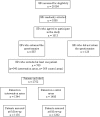Effect of a simple information booklet on pain persistence after an acute episode of low back pain: a non-randomized trial in a primary care setting
- PMID: 17684553
- PMCID: PMC1939729
- DOI: 10.1371/journal.pone.0000706
Effect of a simple information booklet on pain persistence after an acute episode of low back pain: a non-randomized trial in a primary care setting
Abstract
Objective: Mass-media campaigns have been known to modify the outcome of low back pain (LBP). We assessed the impact on outcome of standardized written information on LBP given to patients with acute LBP.
Design: A 3-month pragmatic, multicenter controlled trial with geographic stratification.
Setting: Primary care practice in France.
Participants: 2752 patients with acute LBP.
Intervention: An advice book on LBP (the "back book").
Main outcome measures: The main outcome measure was persistence of LBP three months after baseline evaluation.
Results: 2337 (85%) patients were assessed at follow-up and 12.4% of participants reported persistent LBP. The absolute risk reduction of reporting persistent back pain in the intervention group was 3.6% lower than in the control group (10.5% vs. 14.1%; 95% confidence interval [-6.3% ; -1.0%]; p value adjusted for cluster effect = 0.01). Patients in the intervention group were more satisfied than those in the control group with the information they received about physical activities, when to consult their physician, and how to prevent a new episode of LBP. However, the number of patients who had taken sick leave was similar, as was the mean sick-leave duration, in both arms, and, among patients with persistent pain at follow-up, the intervention and control groups did not differ in disability or fear-avoidance beliefs.
Conclusions: The level of improvement of an information booklet is modest, but the cost and complexity of the intervention is minimal. Therefore, the implications and generalizability of this intervention are substantial.
Trial registration: ClinicalTrials.gov NCT00343057.
Conflict of interest statement
Figures
References
-
- Anderson GB. Epidemiological features of chronic low back pain. Lancet. 1999;354:581–5. - PubMed
-
- Waddell G. Edinburgh: Churchill Livingstone; 1998. The back pain revolution. p. 266.
-
- Druss BG, Rosenheck RA, Sledge WH. Health and disability costs of depressive illness in a major US Corporation. Am J Psychiatry. 2000;157:1274–78. - PubMed
-
- Feurstein M, Beatie P. Behavioral factors affecting pain and disability in low back pain: mechanisms and assessment. Phys Ther. 1995;4:267–80. - PubMed
-
- Waddell G, Newton M, Henderson I, Somerville D, Main CJ. A Fear Avoidance Beliefs Questionnaire (FABQ) and the role of fear-avoidance beliefs in chronic low back pain and disability. Pain. 1993;52:157–68. - PubMed
Publication types
MeSH terms
Associated data
LinkOut - more resources
Full Text Sources
Medical
Miscellaneous


